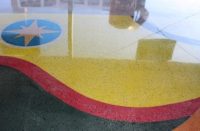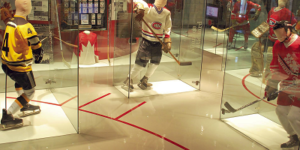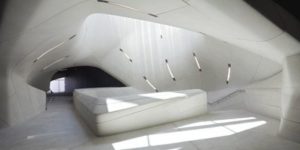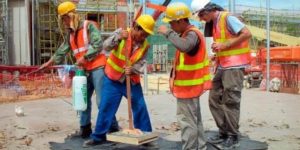
Imagine a $75,000 Maserati Ghibli on display on a cracked, chipped, unevenly colored concrete floor. Having trouble with the visual? The same can be said for Audis and Mini Coopers. They’re much more at home on a pristine, polished floor.
Over the past year, these high-end automobile dealers have turned to Mark Beamish Waterproofing to create stunning polished concrete floors that create an interesting work environment and show off the cars the way they deserve.
The finished floors were polished to a high sheen, largely without any color additives. The ones that used color went with gray or black.
“As part of their vision, many high-end dealerships have a showroom that provides customers with a unique purchasing experience that makes them feel they’re getting the ultimate experience. Polished concrete ‘reflects’ that vision,” says Dan Hennes, an MBW division manager in Livermore, California, who was involved with some of these projects.
Hennes notes that polished concrete is a natural choice for the clean, modern, industrial look companies often want. However, he says, “I think one reason they end up choosing it is its maintainability. There’s very minimal upkeep on a polished concrete floor and the main things that do need to be done are relatively inexpensive.”
A preference for gray
The majority of the automobile dealers that MBW works with prefer no dye, although Audi Beverly Hills chose a dark gray by Ameripolish for a resurfaced area in its showroom (photo above and below).Roughly 1,000 feet of Ardex PC-T, a polished concrete topping, was applied and polished to a level-2 shine.
Petersen Automotive Museum in Los Angeles (see photos on preceding pages) was another job that opted for the sophisticated yet neutral look of gray. Petersen is a museum housing cars from all over the world, including vintage cars, race cars and famous Hollywood cars such as the Batmobile, as driven by Michael Keaton in “Batman” (1989) and “Batman Returns” (1992).
It took about six months from late 2015 to early 2016 for project manager Jose Tovar and his crew to finish 90,000 square feet of polishing and 10,000 square feet of overlay creating a polished concrete look using Ardex PC-T. The team also linearly patched hundreds of feet of concrete where walls once stood. To date, this job features the largest area covered with Ardex PC-T on the West Coast.
“We polished all three floors which involved a lot of prep work,” says Tovar. “The floor was in bad condition. The floor had a lot of challenges and was very uneven. It took a lot to pour and level out the floor, get all the low and high points. We used a lot more material than we had planned to but it turned out beautiful.”

Tovar says the Ardex self-leveling topping performed well, especially considering that it was poured between a half inch and two inches thick to make it level. “We polished it, stained it and sealed it,” Tovar says, “starting with 30 metal-grit pads, all the way to 800.”
Working around problems
Hennes was project manager on the Mini Cooper of Camarillo, California, job that was his biggest polish-and-dye project to date. It involved using Prosoco Consolideck LS and LSGuard and a black dye by Ameripolish to finish 15,000 square feet of floor.
The job’s biggest challenge was the flatness of the concrete. The flatter the concrete, says Hennes, the more consistent level of aggregate exposure you can get when polishing. “Unfortunately, this one was very uneven, so we had a wide range of aggregate exposure. We had to grind much lower than normal for a more consistent look.”
Like the usual challenges of working around other trades and the general contractor’s schedule, the polishing work required that they have the floor to themselves, with no other traffic. Scheduling that is always hard, but it’s imperative to getting a high-quality floor.
“If people are walking on it they will create stains that won’t come out,” Hennes says. “The fast-track schedule we had on this job didn’t allow us to have the floor all to ourselves so we had to figure out how to do it in sections and block it off.”
Nonslip qualities required
Maserati has a facility in Thousand Oaks, California, where cars get delivered for service (photo at right). Originally, the area was covered with an awning and the concrete surface was further protected with a coating.
“They were having issues with moisture,” Hennes says. “If you put a coating down where there’s high vapor drive you get blistering unless you treat for it. An alternative way to do that was to come in and polish the concrete.” Their solution involved a really deep grind to expose the aggregate and make the concrete look like marble.
This 2,500-square-foot area of older concrete had to be ground quite heavily, and since it was where customers routinely exited their cars, it had to be slip-resistant. “We couldn’t get it too shiny,” Hennes says, “so our final product on this was a clear sealer from L. M. Scofield with an aluminum oxide that gave it the nonslip they required.”
Project at a Glance
Clients: A car museum; and Audi, Maserati and Mini Cooper automobile dealerships
Concrete coating and resurfacing: Mark Beamish Waterproofing, Anaheim, California
www.markbeamish.com
Scope of project: A notable square footage of concrete was resurfaced and polished or coated with polishable overlays in a museum and for customer facilities in three high-end car dealerships.
Most challeing aspect: Old, uneven and damaged concrete had to be leveled, coated and polished on short schedules and while sharing the space with other trades.
Products used: Prosoco Consolideck LS and LS Guard sealer, Ardex PC-T topping, black and gray dyes by Ameripolish, and clear sealer from L. M. Scofield.




















